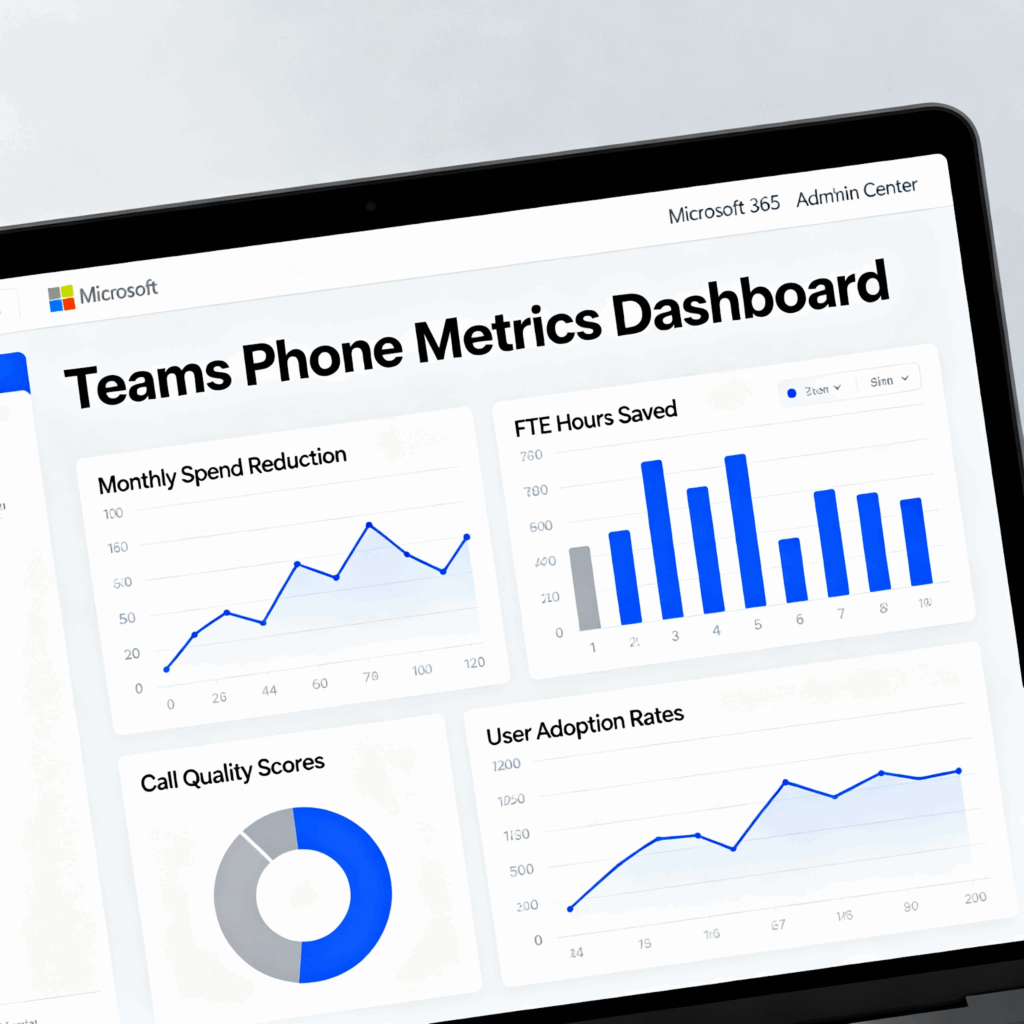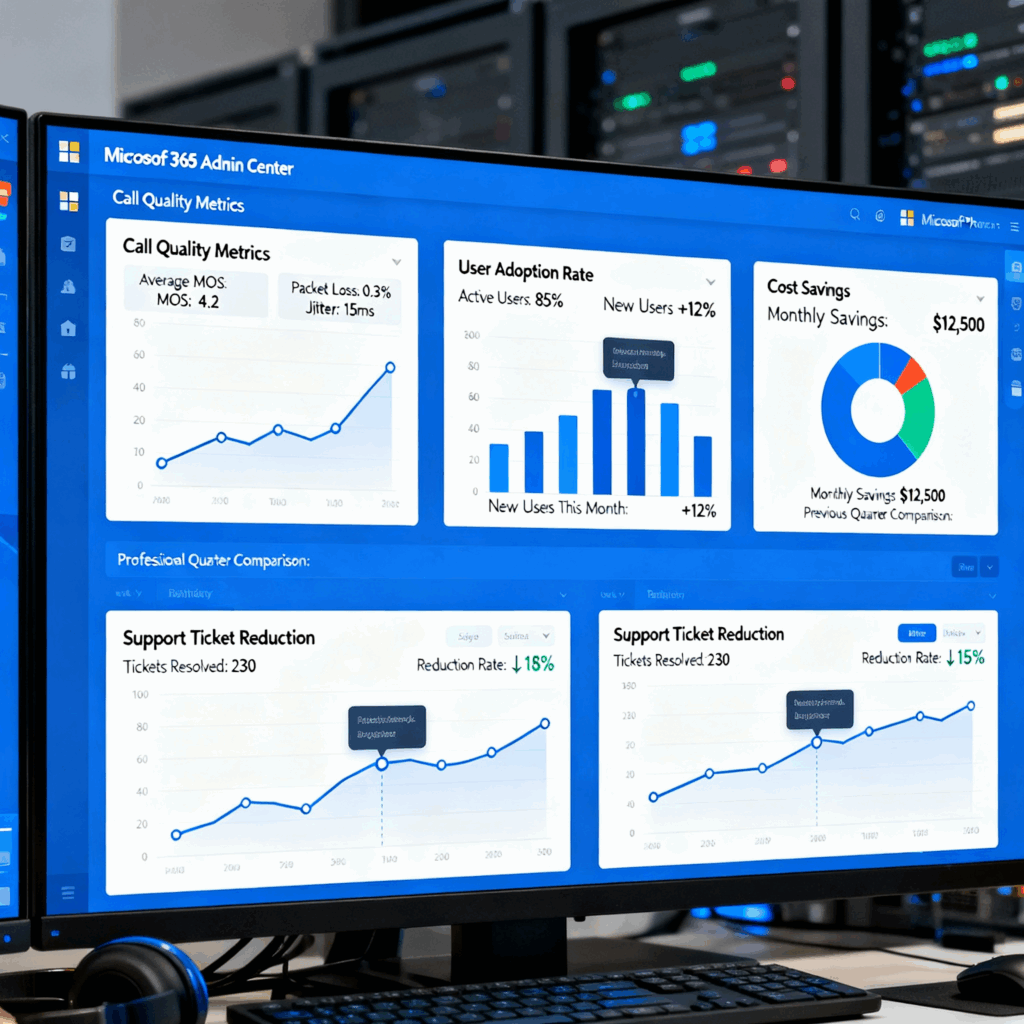
Microsoft Teams Phone delivers 143% ROI for enterprises and 146% ROI for SMBs with payback periods under six months.
This doesn’t just make it one of the most cost-effective telephony modernization investments available today, but it’s one of the most publicly justifiable solutions.
Ergo: You don’t have to wait and see if you get a good ROI on your Teams Phone investment. It’s already been proven by tons of businesses worldwide.
As you replace your legacy phone system with a cloud-based solution, the quantified business impact demonstrates clear financial benefits alongside enhanced productivity and collaboration.
This comprehensive analysis examines Microsoft-verified Forrester studies, breaks down key performance metrics, and outlines how your organization can maximize Teams Phone ROI across enterprise and SMB deployments.
Note: The stats that follow are recalled from original research, Forrester’s Total Economic Impact of Microsoft Teams Phone study, and Microsoft-conducted modelling.
Signs You’re Ready to Expand from Teams to Teams Phone
Recognize any of these?
- High internal calling volume: Frequent peer-to-peer voice calls in Teams
- Heavy meeting usage: Users rely on Teams meetings instead of desk phones
- Multiple telephony vendors: Complex billing and support across legacy PBXs
- Mobile workforce gaps: Teams mobile calls but separate mobile plans
- IT management overhead challenges: Managing Teams and PSTN systems separately
If these “signs” sound familiar, Teams Phone can consolidate collaboration and calling onto one platform—driving incremental ROI without starting from scratch.
The Quantifiable Teams Phone ROI Stats
Teams Phone delivers compelling financial returns backed by extensive research:
Enterprise Organizations (10,000 employees):
- 143% ROI over three years with payback period under 6 months
- $19.7 million in total benefits (risk-adjusted present value)
- $10.8 million cost savings from replacing legacy voice solutions
- $7.9 million in productivity gains from improved communication
Small and Medium-Sized Businesses (100 employees):
- 146% ROI over three years with payback period under 6 months
- $304,000 in total benefits (risk-adjusted present value)
- $95,000 cost savings from replacing legacy voice solutions
- $79,000 in productivity gains from improved communication
Teams Phone Mobile Evolution:
- 225% ROI projected for organizations adopting mobile-first calling
- Up to 20% productivity gain per user annually
- 40% reduction in redundant on-premises phone lines
These outcomes translate into accelerated revenue growth, reduced operating costs, and faster time-to-value for Teams Phone adopters across all organizational sizes.
What This Quantified Business Impact Looks Like
Cost Savings from Replacing Legacy Phone Solutions
The most immediate ROI driver comes from eliminating expensive traditional telephony infrastructure. You can achieve substantial savings by consolidating multiple vendor relationships and deprecating hardware-intensive systems.
Enterprise Cost Elimination:
- Hardware savings: Eliminate PBX equipment, reducing power and cooling costs by up to 90%
- Licensing consolidation: Replace multiple telephony vendors with unified Microsoft 365 licensing
- Usage cost reduction: Significantly reduce long-distance charges and international calling fees
- Infrastructure footprint: One telecommunications company reduced telephony infrastructure by 90% in data centers
SMB Cost Optimization:
- PBX replacement: Avoid $30,000 one-time hardware replacement costs
- Mobile reimbursement reduction: Cut monthly mobile costs from $50 to $5 per user for non-mobile employees
- Simplified billing: Single vendor relationship vs. multiple telecom providers
Real-World Example: ScottMadden consulting firm achieved $90,000 annual savings ($7,500 monthly) after implementing Teams Phone, while enhancing data security through Microsoft E5 licensing integration.
Reduced IT Management Burden
Teams Phone dramatically simplifies telephony administration by integrating with existing Microsoft 365 management workflows, eliminating specialized skills requirements and reducing support overhead.
Enterprise IT Efficiency:
- Unified administration: Single Microsoft 365 Admin Center for all communications
- Support staff reduction: Decrease from 3 FTEs to 2 FTEs managing telephony
- Eliminated specialized skills: No need for PBX-specific technical expertise
- Automatic updates: Cloud-based system with seamless feature rollouts
SMB IT Streamlining:
- Management effort reduction: Decrease from 0.5 FTE to 0.1 FTE
- Simplified troubleshooting: Single platform for voice and collaboration issues
- Reduced vendor management: Eliminate multiple telecom provider relationships
One financial services company noted: “The benefits around being able to manage the security all within the Microsoft Teams and 365 platform. Being able to keep it all within one platform has been beneficial from the legal and client standpoint.”
Enhanced User Productivity and Collaboration
Teams Phone integration eliminates communication friction, enabling seamless transitions between voice calls, video meetings, chat, and file sharing within a unified platform.
Quantified Time Savings:
- Highly mobile users: Save 1.6 hours per week on average
- Standard users: Save 15 minutes per week on average
- Productivity recapture: 50% of saved time is repurposed productively
Workflow Integration Benefits:
- Click-to-call functionality: Direct calling from any Teams interface
- Seamless device switching: Transfer calls between desktop, mobile, and desk phones
- Integrated presence: Automatic status updates across all communication channels
- Unified history: Single location for all communication records
Teams Phone vs. Traditional PBX: TCO Analysis
The total cost of ownership comparison reveals significant advantages for Teams Phone across multiple cost categories.
Traditional PBX Annual Costs:
- Hardware purchase/lease: $28 per user per month
- Maintenance contracts: Substantial ongoing expenses
- Long-distance/international: $10 per user per month
- Specialized IT management: 3 FTEs @ $150,000 annual salary
Teams Phone Annual Costs:
- Teams Phone Standard license: $120 per user ($10/month)
- PSTN connectivity: $5 per user per month (varies by option)
- Reduced IT overhead: 33% reduction in telephony management effort
Net Savings: Organizations achieve 45% reduction in total telephony costs independent of productivity gains.
Case Study: Au Firm Cost Transformation
A recent Australian firm case study demonstrates practical cost savings: monthly phone bills reduced from AUD $4,500 to approximately AUD $1,000, achieving over 20% cost reduction while improving global collaboration capabilities.
Industry-Specific ROI Metrics
Different industries realize varying ROI levels based on their unique communication requirements and existing infrastructure.
Professional Services
- 40x ROI through reduced proposal time and optimized billable hours
- Enhanced client responsiveness through integrated communications
- Streamlined project collaboration across distributed teams
Healthcare Organizations
- HIPAA compliance built-in, reducing compliance infrastructure costs
- Improved care coordination through secure, integrated communications
- Cost savings from eliminating traditional phone systems while maintaining compliance
Financial Services
- Enhanced security with enterprise-grade encryption and conditional access
- Streamlined client communications with integrated CRM calling
- Simplified compliance recording and audit workflows
Manufacturing
- Global deployment standardization across facilities
- Reduced international calling costs through intelligent cloud routing
- Improved operational efficiency through unified communications

Implementation Success Factors
Maximizing Teams Phone ROI requires strategic planning, proper deployment methodology, and ongoing optimization.
Pre-Deployment ROI Optimization
Network Readiness Assessment:
- Ensure Quality of Service (QoS) configuration for voice traffic
- Validate bandwidth capacity for concurrent calling
- Test emergency calling (E911) requirements for compliance
Legacy System Audit:
- Document all current telephony costs and vendor contracts
- Identify contract termination dates and exit fees
- Map existing phone number inventory for porting strategy
Licensing Optimization:
- Choose between Calling Plans, Direct Routing, or Operator Connect based on requirements
- Evaluate Microsoft 365 E5 bundles vs. standalone licensing
- Plan for Teams Phone Mobile adoption timeline
Deployment Best Practices
Phased Rollout Strategy:
- Start with pilot groups of 20-50 power users
- Include representation from different departments and use cases
- Expand gradually based on feedback and lessons learned
User Training Programs:
- Deliver role-specific workshops focusing on relevant features
- Create video libraries for on-demand learning
- Establish internal Teams Phone champions for peer support
Number Porting Management:
- Coordinate with carriers to minimize business disruption
- Plan porting schedules around business-critical periods
- Maintain backup connectivity during transition periods
Post-Deployment ROI Monitoring
Key Performance Indicators:
- Cost metrics: Monthly telephony spend reduction, eliminated vendor contracts
- Productivity metrics: Time saved on communications tasks, meeting efficiency
- Quality metrics: Call completion rates, audio quality scores, uptime percentage
- User adoption: Active calling users, feature utilization rates
Monitoring Tools:
- Microsoft 365 Admin Center call analytics
- Teams Call Quality Dashboard (CQD)
- Usage reports and adoption metrics
- Third-party analytics platforms for advanced insights

Measuring and Tracking Teams Phone ROI
Establishing comprehensive measurement frameworks ensures ongoing ROI optimization and demonstrates value to stakeholders.
Financial Tracking Methods
Cost Reduction Measurement:
- Track monthly telephony expenses before and after implementation
- Monitor eliminated vendor contracts and hardware depreciation
- Calculate IT labor hour savings from simplified management
Productivity Quantification:
- Survey users on time savings from integrated communications
- Measure meeting efficiency improvements through Teams integration
- Track reduced support ticket volumes for telephony issues
Advanced ROI Opportunities
Contact Center Integration:
- Replace legacy contact center solutions with Teams-based alternatives
- Integrate with Microsoft Dynamics 365 for unified customer experience
- Leverage AI-powered call insights and summaries
Compliance and Recording:
- Utilize built-in recording capabilities vs. third-party solutions
- Implement automated compliance workflows
- Reduce legal discovery costs through integrated retention policies
AI Integration:
- Deploy Microsoft Copilot for call summaries and insights
- Automate call transcription and action item extraction
- Enhance customer service through AI-powered analytics
Real-World Teams Phone ROI Case Studies
Enterprise Case Study: Telecommunications Company
Challenge: Multiple legacy PBX systems, high telephony costs, poor collaboration across global offices
Solution: 36,000 users migrated to Teams Phone with Direct Routing
Results:
- 90% reduction in telephony infrastructure footprint
- Eliminated specialized gateway hardware requirements
- Significant reduction in support staff from multiple teams to single team
- Enhanced acquisition integration capability for rapid company growth
SMB Case Study: Healthcare Nonprofit
Challenge: Aging VoIP PBX system, limited mobile flexibility, high maintenance costs
Solution: 590 users implemented Teams Phone with calling plans
Results:
- “Rock-solid reliable” system with improved audio quality
- Unified management through Microsoft 365 admin center
- Enhanced security and compliance capabilities
- Significant cost reduction vs. previous hosted solution
Maximizing Your Teams Phone ROI
If you’re sold on the ROI of Teams Phone, your next step is to optimize it from day one. Here’s how to get the most from your investment right away.
Optimization Strategies
Feature Adoption Campaigns:
- Drive usage of advanced calling features like call queues and auto attendants
- Promote mobile app adoption for remote work flexibility
- Encourage integration with business applications
Integration Maximization:
- Connect with CRM systems for click-to-dial functionality
- Integrate with help desk platforms for unified support
- Leverage Power Platform for custom calling workflows
Continuous Training:
- Regular user education sessions on new features
- Best practice sharing across departments
- Advanced administrator training for optimization
Cost Optimization Techniques
Regular Review Processes:
- Monthly analysis of calling patterns and usage
- Annual contract negotiations with PSTN providers
- Optimization of calling plans based on actual usage data
Advanced Feature Utilization:
- Implement auto attendants to reduce receptionist requirements
- Deploy call queues for improved customer service efficiency
- Utilize call analytics for continuous improvement
Teams Phone ROI Calculator Framework
To help calculate your Teams Phone ROI, you should establish structured ROI calculation methodologies:
Input Variables:
- Current telephony monthly costs per user
- IT management hours dedicated to telephony
- Number of users by mobility level (highly mobile vs. standard)
- International calling volumes and costs
Output Projections:
- Three-year cost savings projections
- Productivity gain quantification
- Implementation cost recovery timeline
- Net present value calculations
Conclusion: Achieve Teams Phone ROI Before Competitors
Teams Phone represents a compelling modernization opportunity with proven ROI metrics spanning enterprises and SMBs. The combination of immediate cost savings, productivity improvements, and strategic advantages creates a strong business case for implementation.
With 143-146% ROI and sub-six-month payback periods proven across multiple Forrester studies, Teams Phone delivers quantifiable business value while future-proofing communications infrastructure. If you act decisively, you can gain competitive advantages through enhanced collaboration, reduced costs, and improved customer experience.
The key to maximizing ROI lies in strategic planning, proper implementation methodology, and ongoing optimization. By following proven best practices and leveraging comprehensive measurement frameworks, you can realize the full potential of their Teams Phone investment while positioning themselves for continued growth in an increasingly connected business environment.
Do you need help achieving the Teams Phone ROI figures we know are now possible?
That’s where the good folks at Cloud Revolution come in. We don’t like to call ourselves the Teams experts, but we do like to call ourselves the Teams people.
We’re people like Adam Ball, co-founder of the community event, Comms vNext, and Chad McGreanor, who has over 20 years of experience in Microsoft-focused senior roles spanning practice management, consulting, and managed services.
When you opt for Cloud Revolution, you benefit from:
- Microsoft Partner of the Year 2023, Finalist 2022 & 2024
- Proven track record of delivering measurable business outcomes
- Trusted by leading organizations across industries
- Human-centered, relationship-driven approach
Ready to start planning your Teams Phone migration?